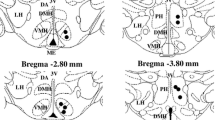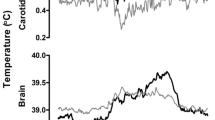Summary
In two conscious dogs in standardized environments, the temperatures of spinal cord or hypothalamus were altered independently of each other and the resulting changes in heat production (shivering) and in respiratory evaporative heat loss (panting) were measured and correlated with these changes in temperatures.
Spinal cord cooling at 18 and 24°C air temperature increased heat production by about −0.7 Kcal/(kg·h·°C). The mean spinal cord temperature at which this occurred was between 37.30 and 37.80°C. Under the same conditions hypothalamic cooling increased heat production by about −0.7 Kcal/(kg·h·°C). The temperature at which this occurred was between 38.40 and 38.75°C.
Spinal cord heating at 18, 24, and 30°C air temperature increased the respiratory evaporative heat loss by +0.9 to 1.2 Kcal/(kg·h·°C) above a mean spinal cord temperature between 40.00 and 41.50°C. Hypothalamic heating at 30°C air temperature increased the respiratory evaporative heat loss by +0.9 Kcal/(kg·h·°C). For all environments the hypothalamic threshold temperature lay between 38.75 and 42.40°C.
The results suggest that in the dog, spinal cord and hypothalamus represent basically equivalent core sensors of temperature.
Similar content being viewed by others
References
Adams, Th.: Body-temperature regulation in the normal and cold-acclimatized cat. J. appl. Physiol.18, 772–777 (1963).
Andersen, H. T., Andersson, B., Gale, C. C.: Central control of cold defense mechanisms and the release of “Endopyrogen” in the goat. Acta physiol. scand.54, 159–174 (1962).
Andersson, B., Gale, C. C., Hökfelt, B., Ohga, A.: Relation of preoptic temperature to the function of the Sympathico-Adrenomedullary System and the adrenal cortex. Acta physiol. scand.61, 182–191 (1964).
Andersson, B., Grant, R., Larsson, S.: Central control of heat loss mechanisms in the goat. Acta physiol. scand.37, 261–281 (1956).
Baldwin, B. A., Ingram, D. L.: Effects of cooling hypothalamus in the pig. J. Physiol. (Lond.)186, 72 P (1966).
Barbour, H. G.: Die Wirkung unmittelbarer Erwärmung und Abkühlung der Wärmezentra. Naunyn-Schmiedebergs Arch. exp. Path. Pharmak.70, 1–15 (1912).
Benzinger, H. T.: Heat regulation: homeostasis of central temperature in man. Physiol. Rev.49, 671–759 (1969).
Betz, E., Brück, K., Hensel, H., Jarai, I., Malan, A.: Verhalten des Energieumsatzes bei umschriebener Hypothalamuskühlung an der wachen Katze. Pflügers Arch. ges. Physiol.272, 76–77 (1960).
Eliasson, S., Ström, G.: On the localization in the cat of hypothalamic and cortical structures influencing cutaneous blood flow. Acta physiol. scand.20, Suppl.70, 113–118 (1950).
Euler, C. von: The gain of the hypothalamic temperature regulating mechanisms. Progress in brain research, vol. 5, pp. 127–131, Amsterdam: Elsevier 1964.
Findlay, J. D., Hales, J. R. S.: Hypothalamic temperature and the regulation of respiration of the ox exposed to severe heat. J. Physiol. (Lond.)203, 651–663 (1969).
Fusco, M. M., Hardy, J. D., Hammel, H. T.: Interaction of central and peripheral factors in physiological temperature regulation. Amer. J. Physiol.200, 572–580 (1961).
Hales, J. R. S., Jessen, C.: Increase of cutaneous moisture loss caused by local heating of the spinal cord in the ox. J. Physiol. (Lond.)204, 40–42P (1969).
Hammel, H. T., Hardy, J. D., Fusco, M. M.: Themoregulatory response to hypothalamic cooling in unanesthetized dogs. Amer. J. Physiol.198, 481–486 (1960).
—, Jackson, D. C., Stolwijk, A. J., Hardy, J. D., Strømme, S. B.: Temperature regulation by hypothalamic proportional control with an adjustable set point. J. appl. Physiol.18, 1146–1154 (1963).
Hellon, R.-F.: Environmental temperature and firing rate of hypothalamic neurons. Experientia (Basel)25, 610 (1969).
Hellstrøm, B., Hammel, H. T.: Some characteristics of temperature regulation in the unanesthetized dog. Amer. J. Physiol.213, 547–556 (1967).
Hemingway, A., Rasmussen, Th., Wikoff, H., Rasmussen, A. T.: Effects of heating hypothalamus of dogs by diathermy. J. Neurophysiol.3, 329–338 (1940).
Hume, D. M., Ganong, W. F.: A method for accurate placement of electrodes in the hypothalamus of the dog. Electroenceph. clin. Neurophysiol.8, 136–140 (1956).
Ingram, S. L., Whittow, G. C.: The effect of heating the hypothalamus on respiration in the ox. J. Physiol. (Lond.).163, 200–210 (1962).
Jacobsson, F. H., Squires, R. D.: Thermoregulatory responses of the unanesthetized cat to preoptic and environmental temperature. U.S. Naval Air Report NADC-NR-6815 (1970).
Jessen, C.: Auslösung von Hecheln durch isolierte Wärmung des Rückenmarks am wachen Hund. Pflügers Arch. ges. Physiol.297, 53–70 (1967).
—, Meurer, K.-A., Simon, E.: Steigerung der Hautdurchblutung durch isolierte Wärmung des Rückenmarks am wachen Hund. Pflügers Arch. ges. Physiol.297, 35–52 (1967).
Klüver, H., Barrera, E.: A method for the combined staining of cells and fibers in the nervous system. J. Neuropath. exp. Neurol.12, 400–403 (1953).
Klussmann, F. W.: Der Einfluß der Temperatur auf die afferente und efferente motorische Innervation des Rückenmarks. I. Temperaturabhängigkeit der afferenten und efferenten Spontantätigkeit. Pflügers Arch.305, 295–315 (1969).
Kullmann, R., Jessen, C., Simon, E.: Beeinflussung der Aktivität spinaler und supraspinaler Vasomotorenzentren durch Änderung der Rückenmarkstemperatur. Pflügers Arch.307, 99 (1969).
Lim, R. K. S., Liu, C., Moffitt, R. L.: A stereotaxic atlas of dog's brain. Springfield, Ill.: Ch. C. Thomas 1960.
Magoun, H. W., Harrison, F., Brobeck, J. R., Ranson, S. W.: Activation of heat loss mechanisms by local heating of the brain. J. Neurophysiol.1, 101–114 (1938).
Meurer, K.-A., Jessen, C., Iriki, M.: Kältezittern während isolierter Kühlung des Rückenmarks nach Durchschneidung der Hinterwurzeln. Pflügers Arch. ges. Physiol.293, 236–255 (1967).
Nakayama, T., Hammel, H. T., Hardy, J. D., Eisenman, J. S.: Thermal stimulation of electrical activity of single units of the preoptic region. Amer. J. Physiol.204, 1122–1126 (1963).
Pierau, F.-K., Klee, M. R., Klussmann, F. W.: Effects of local hypo- and hyperthermia on mammalian spinal motoneurones. Fed. Proc.28, 1006–1010 (1969).
Simon, E., Iriki, M.: Ascending neurons highly sensitive to variations of spinal cord temperature. Symposium international de thermoregulation comportementale. Lyon 1970. J. Physiol. (Paris) (1970/71).
—, Rautenberg, W., Thauer, R., Iriki, M.: Auslösung thermoregulatorischer Reaktionen durch lokale Kühlung im Vertebralkanal. Naturwissenschaften50, 337 (1963).
————: Die Auslösung von Kältezittern durch lokale Kühlung im Wirbelkanal. Pflügers Arch. ges. Physiol.281, 309–331 (1964).
Singer, M.: The brain of the dog in section. Philadelphia-London: Saunders 1962.
Wit, A., Wang, S. C.: Effects of increasing ambient temperature on unit activity in the preoptic-anterior hypothalamus (PO/AH). Fed. Proc.26, 1672 (1967).
Wünnenberg, W., Brück, K.: Single unit activity evoked by thermal stimulation of the cervical spinal cord in the guinea-pig. Nature (Lond.)218, 1268–1269 (1968).
Author information
Authors and Affiliations
Rights and permissions
About this article
Cite this article
Jessen, C., Mayer, E.T. Spinal cord and hypothalamus as core sensors of temperature in the conscious dog. Pflugers Arch. 324, 189–204 (1971). https://doi.org/10.1007/BF00586418
Received:
Issue Date:
DOI: https://doi.org/10.1007/BF00586418




